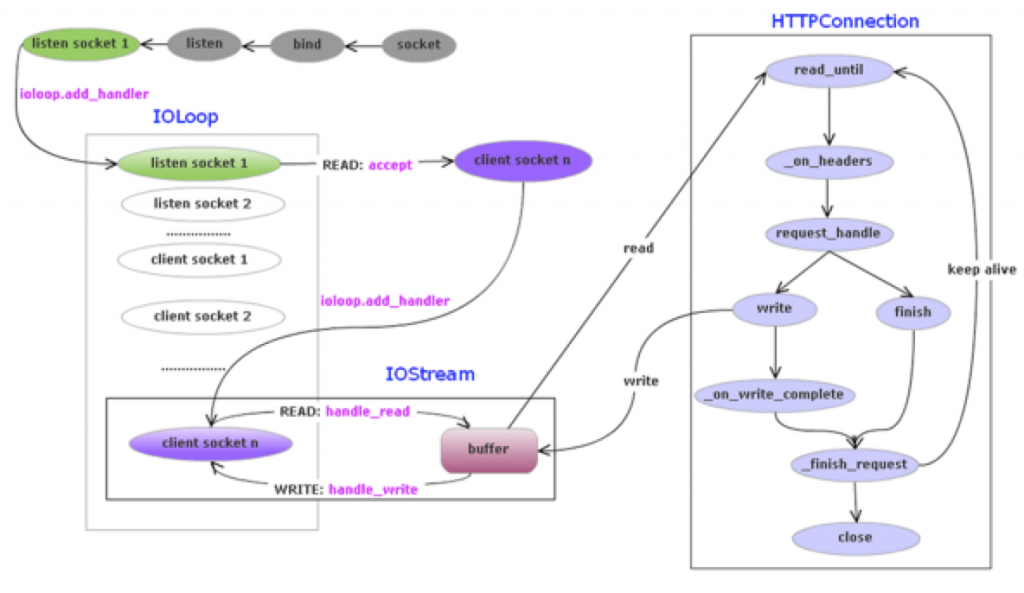Tornado是一款轻量级的Web服务器,同时又是一个开发框架。采用单线程非阻塞I/O模型(epoll),主要是为了应对高并发 访问量而被开发出来,尤其适用于comet应用。
Tornado服务器3大核心模块:
(1) IOLoop
Tornado为了实现高并发和高性能,使用了一个IOLoop来处理socket的读写事件,IOLoop基于epoll,可以高效的响应网络事件。这是Tornado高效的保证。
tornado.ioloop.IOLoop.instance().start()
IOLoop使用了单例模式,处理所有IO事件,
实现为EPollIOLoop->PollIOLoop->IOLoop->Configurable
IOLoop中有四个重要的数据集: _events 和 _handlers 保存I/O事件和对应的处理器, _callbacks 和 _timeouts 保存(超时)回调。
关键函数:
def initialize(self, impl, time_func=None): super(PollIOLoop, self).initialize() self._impl = impl if hasattr(self._impl, 'fileno'): set_close_exec(self._impl.fileno()) self.time_func = time_func or time.time #handlers 是一个函数集字典 self._handlers = {} self._events = {} #回调函数集合 self._callbacks = [] self._callback_lock = threading.Lock() self._timeouts = [] self._cancellations = 0 self._running = False self._stopped = False self._closing = False self._thread_ident = None self._blocking_signal_threshold = None self._timeout_counter = itertools.count() # Create a pipe that we send bogus data to when we want to wake # the I/O loop when it is idle self._waker = Waker() self.add_handler(self._waker.fileno(), lambda fd, events: self._waker.consume(), self.READ)
其中,waker是一个发伪数据用的类,在需要时,我们可以用它唤醒空闲的I/O Loop。当我们调用add_callback时,为了让回调函数运行,可能会需要使用它发送一个伪数据。
#将文件描述符发生相应的事件时的回调函数对应 def add_handler(self, fd, handler, events): """Registers the given handler to receive the given events for fd.""" self._handlers[fd] = stack_context.wrap(handler) #在 epoll 中注册对应事件 #epoll_ctl self._impl.register(fd, events | self.ERROR)
其中stack_context.wrap()对handler进行封装,封装后记录了上下文信息。而_impl是对epoll的封装。
所以,只要把所有事件在IOLoop中进行注册,运行start函数后,就会进入进程的监听循环,循环监听所有的fd,并调用fd对应的handler。循环过程参考start()函数。
def start(self): while True: with self._callback_lock: callbacks = self._callbacks self._callbacks = [] #运行所有callback for callback in callbacks: self._run_callback(callback) #取事件 event_pairs = self._impl.poll(poll_timeout) self._events.update(event_pairs) while self._events: fd, events = self._events.popitem() try: #调用事件handler fd_obj, handler_func = self._handlers[fd] handler_func(fd_obj, events) except (OSError, IOError) as e: if errno_from_exception(e) == errno.EPIPE: # Happens when the client closes the connection pass else: self.handle_callback_exception(self._handlers.get(fd)) except Exception: self.handle_callback_exception(self._handlers.get(fd))
当poll中发现fp有read事件时,会调用对应的callback方法。如果fd是监听的fd,那么这个回调handler就是accept_handler函数(见下面HttpConnection的bind和add_scokets函数)。该方法会Accept连接并且紧跟着创建IOStream对象,read_until方法读完数据后,则调用_run_callback把处理函数(self._header_callback)加到IOLoop中,等到下次轮询时在最前面处理。
(2) IOStream
为了在处理请求的时候,实现对socket的异步读写, Tornado实现了IOStream类,用来处理socket的异步读写,负责异步通讯。
主要包括3个函数,
1.read_bytes(bytes,callback)在有固定的字节的数据到来的时候调用回调函数
2.read_until(delimiter,callback)在读取到固定的字符序列结尾后调用回调函数
3.write(data):异步写
(3) HTTPConnection
这个类用来处理http的请求, 包括读取http请求头, 读取post过来的数据,调用用户自定义的处理方法。以及把响应数据写给客户端socket。
def bind(self, port, address=None, family=socket.AF_UNSPEC, backlog=128): sockets = bind_sockets(port, address=address, family=family,backlog=backlog) if self._started: self.add_sockets(sockets) else: self._pending_sockets.extend(sockets) def add_sockets(self, sockets): if self.io_loop is None: self.io_loop = IOLoop.current() for sock in sockets: self._sockets[sock.fileno()] = sock add_accept_handler(sock, self._handle_connection,io_loop=self.io_loop)
socket启动后,监听各个sockets,事件到来时,调用_handle_connection。
def _handle_connection(self, connection, address): if self.ssl_options is not None: connection = ssl_wrap_socket(connection,self.ssl_options, server_side=True, do_handshake_on_connect=False) if self.ssl_options is not None: stream = SSLIOStream(connection, io_loop=self.io_loop, max_buffer_size=self.max_buffer_size, read_chunk_size=self.read_chunk_size) else: stream = IOStream(connection, io_loop=self.io_loop, max_buffer_size=self.max_buffer_size, read_chunk_size=self.read_chunk_size) self.handle_stream(stream, address) def handle_stream(self, stream, address): context = _HTTPRequestContext(stream, address, self.protocol) conn = HTTP1ServerConnection( stream, self.conn_params, context) self._connections.add(conn) conn.start_serving(self) def start_serving(self, delegate): assert isinstance(delegate, httputil.HTTPServerConnectionDelegate) self._serving_future = self._server_request_loop(delegate) # Register the future on the IOLoop so its errors get logged. self.stream.io_loop.add_future(self._serving_future, lambda f: f.result())
如前面所述,这里Accept连接并且紧跟着创建IOStream对象(不考虑https),调用handle_stream->start_serving->_server_request_loop处理请求。最后会调用_read_message读取数据,并注册回调函数。
最后抄一张图过来:

参考:
http://www.cnblogs.com/Bozh/archive/2012/07/22/2603976.html
http://kenby.iteye.com/blog/1159621
http://www.nowamagic.net/academy/detail/13321030
http://www.yeolar.com/note/2013/02/09/tornado-async-networking/
源码: